 Absolute Antibody’s recombinant antibody technology allows us to convert any antibody into a fragment, including single chain Fv (scFv), Fab or Fab2 formats. Antibody fragments offer an ideal alternative to full-length antibodies in certain situations, as they enable better tissue penetration, reduce non-specific binding, and increase antibody stability and solubility. Antibody fragments can also improve localization in super-resolution methods, or reduce false positives in sandwich ELISA-type diagnostic tests.
Absolute Antibody’s recombinant antibody technology allows us to convert any antibody into a fragment, including single chain Fv (scFv), Fab or Fab2 formats. Antibody fragments offer an ideal alternative to full-length antibodies in certain situations, as they enable better tissue penetration, reduce non-specific binding, and increase antibody stability and solubility. Antibody fragments can also improve localization in super-resolution methods, or reduce false positives in sandwich ELISA-type diagnostic tests.
Our recombinant antibody catalog includes popular clones engineered into various fragment formats, while our custom engineering service enables the creation of fragments from any existing antibody. Contact us to discuss your project!
For more background information on the types and uses of antibody fragments, please visit our Antibody Resource here. Below, we provide some additional details on our approach to the Fab2 format.
Spotlight on: Fab2 Antibodies
Fab2 antibody fragments are used in many applications or assays where the presence of the Fc region may cause problems. They are traditionally made by enzymatic cleavage of full-length antibodies, but this causes a range of contaminants as by-products and the resulting fragment is comparatively unstable.
At Absolute Antibody, we produce Fab2 antibodies recombinantly. Our recombinant version, called the AbFab2™ fragment, has a proprietary dimerization motif in place of the hinge region, which improves stability of the fragment. Contaminating fragments are not generated, and a His tag is added for purification. As with all recombinant antibodies, the fragments are chemically defined with high purity and ensured batch-to-batch reproducibility.
See the figure below to compare the standard industry approach to the Absolute Antibody approach. In addition, the below ELISA data demonstrates that our Fab2 antibodies have nearly identical behavior to the original IgG antibodies.

Competition ELISA comparing affinity of different anti-cmyc (9E10, Ab00100) variants: 1.25 μM solutions of murine IgG1 (green), murine Fab2 (black) or human Fab (blue) 9E10 variants were pre-mixed with different concentrations of murine IgG1 9E10:HRP conjugate. These mixtures were then used to probe wells coated with immobilized multi-tag protein (Pr00106). The stronger the binding of the 9E10 variants, the higher the concentration of 9E10:HRP conjugate had to be in order to observe a signal. The weakest binder was hFab, while Absolute Antibody’s Fab2 and mIgG1 behaved almost identically.

